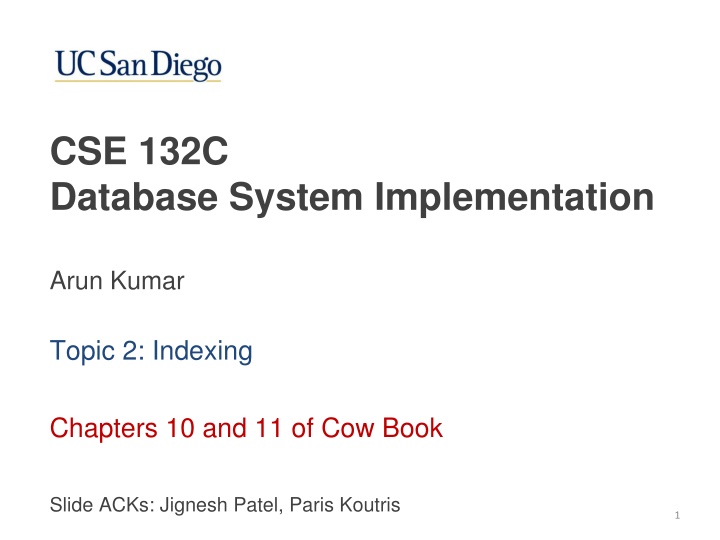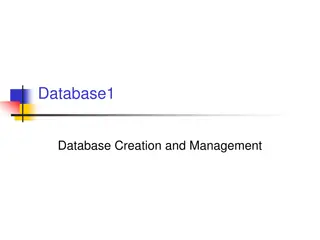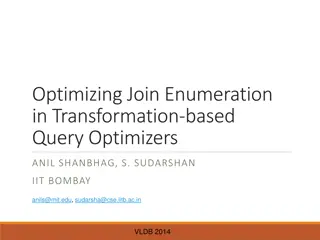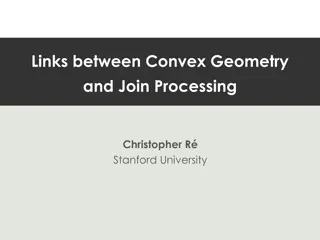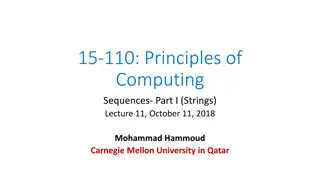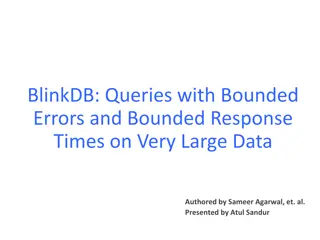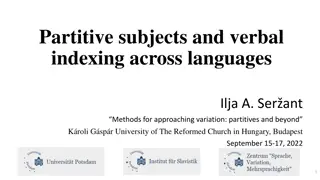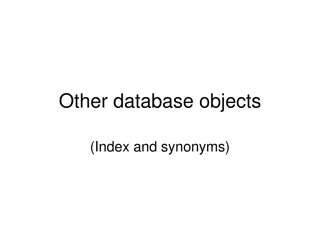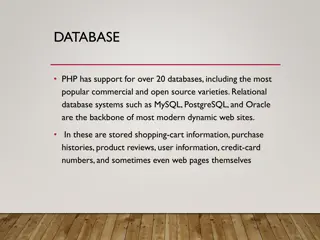Indexing in Database Systems: Enhancing Query Performance
Efficiently retrieve records in a database using indexing techniques such as B+ Tree and Hash Index. Explore the benefits of indexing for selective predicates and different types of searches. Understand the key concepts and operations involved in indexing for improved database system implementation.
Download Presentation

Please find below an Image/Link to download the presentation.
The content on the website is provided AS IS for your information and personal use only. It may not be sold, licensed, or shared on other websites without obtaining consent from the author.If you encounter any issues during the download, it is possible that the publisher has removed the file from their server.
You are allowed to download the files provided on this website for personal or commercial use, subject to the condition that they are used lawfully. All files are the property of their respective owners.
The content on the website is provided AS IS for your information and personal use only. It may not be sold, licensed, or shared on other websites without obtaining consent from the author.
E N D
Presentation Transcript
CSE 132C Database System Implementation Arun Kumar Topic 2: Indexing Chapters 10 and 11 of Cow Book Slide ACKs: Jignesh Patel, Paris Koutris 1
Motivation for Indexing Consider the following SQL query: Movies (M) MovieID Name Year Director SELECT * FROM Movies WHERE Year=2017 Q: How to obtain the matching records from the file? Heap file? Need to do a linear scan! O(N) I/O and CPU Sorted file? Binary search! O(log2(N)) I/O and CPU Indexing helps retrieve records faster for selective predicates! SELECT * FROM Movies WHERE Year>=2000 AND Year<2010 2
Another View of Storage Manager Concurrency Control Access Methods Recovery Manager Sorted File Hash Index Manager B+-tree Index Heap File Buffer Manager I/O Manager I/O Accesses 3
Indexing: Outline Overview and Terminology B+ Tree Index Hash Index 4
Indexing Index: A data structure to speed up record retrieval Search Key: Attribute(s) on which file is indexed; also called Index Key (used interchangeably) Any permutation of any subsetof a relation s attributes can be index key for an index Index key need not be a primary/candidate key Two main types of indexes: B+ Tree index: good for both range and equality search Hash index: good for equality search 5
Overview of Indexes Need to consider efficiency of search, insert, and delete Primarily optimized to reduce (disk) I/O cost B+ Tree index: O(logF(N)) I/O and CPU cost for equality search (N: number of data entries ; F: fanout of non-leaf node) Range search, Insert, and Delete all start with an equality search Hash index: O(1) I/O and CPU cost for equality search Insert and delete start with equality search Not good for range search! 6
What is stored in the Index? 2 things: Search/index key values and data entries Alternatives for data entries for a given key value k: AltRecord: Actual data records of file that match k AltRID: <k, RID of a record that matches k> AltRIDlist: <k, list of RIDs of records that match k> API for operations on records: Search (IndexKey); could be a predicate for B+Tree Insert (IndexKey, data entry) Delete (IndexKey); could be a predicate for B+Tree 7
Overview of B+ Tree Index Index Entries (Non-leaf pages) Entries of the form: (IndexKey value, PageID) Entries of the form: AltRID: (IndexKey value, RID) Data Entries (Leaf pages) Non-leaf pages do not contain data values; they contain [d, 2d] index keys; d is order parameter Height-balanced tree; only root can have [1,d) keys Leaf pages in sorted order of IndexKey; connected as a doubly linked list Q:What is the difference between B+ Tree and B Tree ? 8
Overview of Hash Index Bucket pages 0 Hash function SearchKey 1 h N-1 Overflow pages Primary bucket pages Bucket pages have data entries (same 3 Alternatives) Hash function helps obtain O(1) search time 9
Trade-offs of Data Entry Alternatives Pros and cons of alternatives for data entries: AltRecord: Entire file is stored as an index! If records are long, data entries of index are large and search time could be high AltRID and AltRIDlist: Data entries typically smaller than records; often faster for equality search AltRIDlist has more compact data entries than AltRID but entries are variable-length Q: A file can have at most one AltRecord index. Why? 10
More Indexing-related Terminology Composite Index: IndexKey has > 1 attributes Primary Index: IndexKey contains the primary key Secondary Index: Any index that not a primary index Unique Index: IndexKey contains a candidate key All primary indexes are unique indexes! MovieID Name Year Director IMDB_URL IMDB_URL is a candidate key Index on MovieID? Index on Year? Index on Director? Index on IMDB_URL? Index on (Year,Name)? 11
More Indexing-related Terminology Clustered index: order in which records are laid out is same as (or very close to ) order of IndexKey domain Matters for (range) search performance! AltRecord implies index is clustered. Why? In practice, clustered almost always implies AltRecord In practice, a file is clustered on at most 1 IndexKey Unclustered index: an index that is not clustered MovieID Name Year Director IMDB_URL Index on Year? Index on (Year, Name)? 12
Indexing: Outline Overview and Terminology B+ Tree Index Hash Index 13
B+ Tree Index: Search Root Height = 1 Order = 2 30 13 17 24 33* 34* 38* 39* 2* 3* 5* 7* 19*20* 22* 24* 27*29* 14* 16* Given SearchKey k, start from root; compare k with IndexKeys in non-leaf/index entries; descend to correct child; keep descending like so till a leaf node is reached Comparison within non-leaf nodes: binary/linear search Examples: search 7*; 8*; 24*; range [19*,33*] 14
B+ Tree Index: Page Format index entries Order = m/2 Non-leaf P1 K1 Pm P2 K2 Pm+1 P3 Km Page Pointer to a page with values Km Pointer to a page with Values < K1 Pointer to a page with values s.t. K1 Values < K2 Pointer to a page with values s.t., K2 Values < K3 data entries R1 K1 P0 R2 K2 Pn+1 Rn Kn Leaf Page Next Page Pointer Prev Page Pointer record 1 record 2 record n 15
B+ Trees in Practice Typical order value: 100; so, non-leaf node can have up to 200 index keys Typical occupancy: 67%; so, typical fanout = 133 Computing the tree s capacity using fanout: Height 1 stores 133 leaf pages Height 4 store 1334 = 312,900,700 leaf pages Typically, higher levels of B+Tree cached in buffer pool Level 0 (root) = 1 page = 8 KB Level 1 = 133 pages ~ 1 MB Level 2 = 17,689 pages ~ 138 MB and so on 16
B+ Tree Index: Insert Search for correct leaf L Insert data entry into L; ifL has enough space, done! Otherwise, must splitL(into new L and a new leaf L ) Redistribute entries evenly, copy up middle key Insert index entry pointing to L into parent of L A split might have to propagate upwards recursively: To split non-leaf node, redistribute entries evenly, but push up the middle key (not copy up, as in leaf splits!) Splits grow the tree; root split increases height. Tree growth: gets wider or one level taller at top. 17
B+ Tree Index: Insert Root Example: Insert 8* Split! Height++ 30 13 17 24 33* 34* 38* 39* 2* 3* 5* 7* 19* 20* 22* 24* 27*29* 14* 16* Split! Entry to be inserted in parent node Copied up (and continues to appear in the leaf) 5 3* 5* 2* 7* 8* 18
B+ Tree Index: Insert Example: Insert 8* Insert in parent node. Pushed up (and only appears once in the index) 17 5 13 24 30 Minimum occupancy is guaranteed in both leaf and non-leaf page splits 19
B+ Tree Index: Insert New Root Example: Insert 8* 17 24 5 13 30 33*34*38*39* 2* 3* 5* 7* 8* 19*20*22* 24*27*29* 14*16* Recursive splitting went up to root; height went up by 1 Splitting is somewhat expensive; is it avoidable? Can redistribute data entries with left or right sibling, if there is space 20
Insert: Leaf Node Redistribution Root Example: Insert 8* 30 13 8 17 24 33* 34* 38* 39* 3* 5* 7* 19*20* 22* 24* 27*29* 2* 14* 16* 8* 14* 16* Redistributing data entries with a sibling improves page occupancy at leaf level and avoids too many splits; but usually not used for non-leaf node splits Could increase I/O cost (checking siblings) Propagating internal splits is better amortization Pointer management headaches 21
B+ Tree Index: Delete Start at root, find leaf L where entry belongs Remove the entry; if L is at least half-full, done! Else, if Lhas only d-1entries: Try to re-distribute, borrowing from sibling L If re-distribution fails, mergeL and L into single leaf If merge occurred, must delete entry (pointing to L or sibling) from parent of L. A merge might have to propagate upwards recursively to root, which decreases height by 1 22
B+ Tree Index: Delete Example: Delete 22* Example: Delete 20* Example: Delete 24*? Root 17 24 27 5 13 30 27*29* 24* 27* 29* 33*34*38*39* 2* 3* 5* 7* 8* 19*20*22* 24* 14*16* Deleting 22* is easy Deleting 20* is followed by redistribution at leaf level. Note how middle key is copied up. 23
B+ Tree Index: Delete Example: Delete 24* Need to merge recursively upwards! Must merge leaf nodes! In non-leaf node, remove index entry with key value = 27 30 33* 34* 38* 39* 19* 27* 29* Pull down of the index entry New Root 5 13 17 30 2* 3* 33* 34* 38* 39* 5* 7* 8* 19* 27* 29* 14* 16* 24
Delete: Non-leaf Node Redistribution Suppose this is the state of the tree when deleting 24* Instead of merge of root s children, we can also redistribute entry from left child of root to right child Root 22 30 17 20 5 13 2* 3* 5* 7* 8* 33*34*38*39* 17*18* 20* 21* 22* 27*29* 14*16* 25
Delete: After Redistribution Rotate IndexKeys through the parent node It suffices to re-distribute index entry with key 20; for illustration, 17 also re-distributed Root 17 22 30 5 13 20 2* 3* 5* 7* 8* 33*34*38*39* 17*18* 20* 21* 22* 27*29* 14*16* 26
Delete: Redistribution Preferred Unlike Insert, where redistribution is discouraged for non-leaf nodes, Delete prefers redistribution over merge decisions at both leaf or non-leaf levels. Why? Files usually grow, not shrink; deletions are rare! High chance of redistribution success (high fanouts) Only need to propagate changes to parent node 27
Handling Duplicates/Repetitions Many data entries could have same IndexKey value Related to AltRIDlist vs. AltRID for data entries Also, single data entry could still span multiple pages Solution 1: All data entries with a given IndexKey value reside on a single page Use overflow pages if needed (not inside leaf list) Solution 2: Allow repeated IndexKey values among data entries Modify Search appropriately (rather complicated!) Use RID to get a unique composite key? 28
Order Concept in Practice In practice, order (d) concept replaced by physical space criterion: at least half-full Non-leaf pages can typically hold many more entries than leaf pages, since leaf pages could have long data records (AltRecord) or RID lists (AltRIDlist) Often, different nodes could have different numbers of entries: Variable sized IndexKey AltRecord and variable-sized data records AltRIDlist could leads to different numbers of data entries sharing an IndexKey value 29
B+ Tree Index: Bulk Loading Given an existing file we want to index, multiple record-at-a-time Inserts are wasteful (too many IndexKeys!) Bulk loading avoids this overhead; reduces I/O cost 1. Sort data entries by IndexKey (AltRecord sorts file!) 2. Create empty root page; copy leftmost IndexKey of leftmost leaf page to root (non-leaf) and assign child 3. Go left to right; Insert only leftmost IndexKey from each leaf page into index as usual (NB: fewer keys!) 4. When non-leaf fills up, follow usual Split procedure and recurse upwards, if needed 30
B+ Tree Index: Bulk Loading Insert IndexKey 22 No redistribution! Split again; push up 20 Height++ 14 Insert IndexKey 17 Split; push up 14 5 14 17 20 and so on 2* 3* 5* 7* 17*18* 20* 21* 22* 27* 14*16* Sorted pages of data entries 31
Indexing: Outline Overview and Terminology B+ Tree Index Hash Index 32
Overview of Hash Indexing Reduces search cost to nearly O(1) Good for equality search (but not for range search) Many variants: Static hashing Extendible hashing Linear hashing, etc. (we will not discuss these) 33
Static Hashing Bucket pages Hash function E.g., h(k) = a*k + b 0 1 2 SearchKey k h h(k) mod N N-1 Overflow pages Primary bucket pages N is fixed; primary bucket pages never deallocated Bucket pages contain data entries (same 3 Alts) Search: Overflow pages help handle hash collisions Average search cost is O(1) + avg # overflow pages 34
Static Hashing: Example MovieID 20 15 52 74 Name Inception Avatar Gravity Blue Jasmine Year 2010 2009 2013 2013 Director Christopher Nolan Jim Cameron Alfonso Cuaron Woody Allen N = 3 Hash function: a = 1, b = 0 h(k) = k MOD 3 Say, AltRecord and only one record fits per page! (15, Avatar, ) 0 1 h (52, Gravity, ) 15 MOD 3 = 0 (20, Inception, ) (74, Blue ) 2 74 MOD 3 = 2 35
Static Hashing: Insert and Delete Insert: Equality search; find space on primary bucket page If not enough space, add overflow page Delete: Equality search; delete record If overflow page becomes empty, remove it Primary bucket pages are never removed! 36
Static Hashing: Issues Since N is fixed, number of overflow pages might grow and degrade search cost; deletes waste a lot of space Full reorg. is expensive and could block query processing Skew in hashing: Could be due to bad hash function that does not spread values; but this issue is well-studied/solved by mathematicians Could be due to skew in the data distribution itself (duplicates); this could cause more overflow pages difficult to resolve Extendible (dynamic) hashing helps resolve first two issues 37
Extendible Hashing Local Depth (LD) Idea: Instead of hashing directly to data pages, maintain a dynamic directory of pointers to data pages Directory can grow and shrink; chosen to double/halve Search I/O cost: 1 (2 if direc. not cached) Global Depth (GD) Bucket A 2 4* 12* 32* 16* 2 00 01 10 11 Bucket B 2 1* 13* 41* 17* Bucket C 2 10* Directory Bucket D 2 7* 15* Check last GD bits of h(k) Data Pages Example: Search 17* 10001 Search 42* 10 38
Extendible Hashing: Insert Search for k; if data page has space, add record; done If data page has no more space: If LD < GD, create Split Image of bucket; LD++ for both bucket and split image; insert record properly If LD == GD, create Split Image; LD++ for both buckets; insert record; but also, double the directory and GD++! Duplicate other direc. pointers properly Direc. typically grows in spurts 39
Extendible Hashing: Insert Example: Insert 24* Local Depth (LD) Global Depth (GD) 00 Bucket A No space in bucket A Need to split and LD++ Since LD was = GD, GD++ and direc. doubles 2 4* 12* 32* 16* 2 00 01 10 11 Bucket B 2 1* 13* 41* 17* Bucket C 2 10* Bucket A 3 32* 16* 24* 000 Directory Check last GD bits of h(k) Bucket D 2 7* 15* Bucket A2 3 4* 12* 100 Data Pages 40
Extendible Hashing: Insert Local Depth (LD) Global Depth (GD) Example: Insert 24* Bucket A 3 32* 16* 24* Example: Insert 18* 3 010 000 001 010 011 100 101 110 111 Bucket B 2 1* 13* 41* 17* 1* 41* 17* 25* 3 Example: Insert 25* Bucket C 2 10* 001 18* Need to split bucket B! Since LD < GD, direc. does not double this time Only LD++ on old bucket and modify direc. ptrs Bucket D 2 7* 15* Bucket A2 3 4* 12* Bucket B2 3 13* 41
Extendible Hashing: Delete Search for k; delete record on data page If data page becomes empty, we can merge with another data page with same last LD-1 bits (its historical split image ) and do LD--; update directory pointers In rare cases, historical split image may have split further; then just let this page sit empty for now If all split images get merged back and if all buckets end up with LD < GD, shrink directory by half; GD-- Never does a bucket s LD become > GD! 42
Extendible Hashing: Delete Local Depth (LD) Global Depth (GD) Example: Delete 41* Bucket A 01 2 4* 12* 1 2 Example: Delete 26* 00 01 10 11 Bucket B 2 1* 13* 41* 17* 10 Bucket C is now empty Can merge with A; LD-- Bucket C 2 26* Q: Why did we pick A to merge with? Bucket D 2 7* 15* In practice, deletes and thus, bucket merges are rare. So, directory shrinking is even more uncommon. 43
Static Hashing vs Extendible Hashing Q: Why not let N in static hashing grow and shrink too? Extendible hash directory size is typically much smaller than data pages; with static hash, reorganizing all data pages is far more expensive Hashing skew is a common issue for both; in static hash, this could lead to a large number of overflow pages; in extendible hash, this could blow up directory size (this is OK) If too many data entries share search key (duplicates), overflow pages needed for extendible hash too 44
Indexing: Outline Overview and Terminology B+ Tree Index Hash Index 45
Review Questions 1. What is the difference between a B tree and B+ tree? 2. Between the insert and delete operations of a B+ tree index, when/where is redistribution of entries not preferred? 3. Why is bulk loading better than just iterative inserts from file? 4. Why is a hash index not useful for a range search? 5. Briefly explain 1 pro and 1 con of the extendible hash index over the static hash index. 6. Is it possible to somehow combine at least some of the benefits of B+ tree and hash indexes? :) 46
